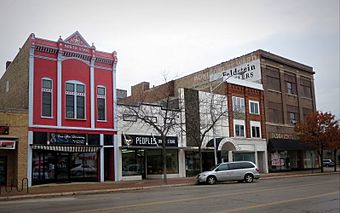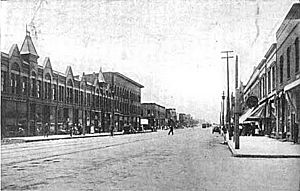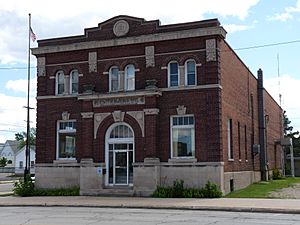Escanaba Central Historic District facts for kids
Quick facts for kids |
|
|
Escanaba Central Historic District
|
|

1200 Block of Ludington Street
|
|
| Location | Roughly 200-1800 blocks Ludington St., Escanaba, Michigan |
|---|---|
| Architectural style | Romanesque, Late Victorian, Modernist |
| NRHP reference No. | 14000123 |
| Added to NRHP | April 7, 2014 |
The Escanaba Central Historic District is a special area in Escanaba, Michigan. It includes many old and important buildings along Ludington Street, from the 200 block all the way to the 1800 block. This district was added to the National Register of Historic Places in 2014 because of its history and unique buildings. It's like a living museum of Escanaba's past!
Contents
- History of Ludington Street
- What the District Looks Like Today
- Exploring the Blocks
- 200 Block: The House of Ludington
- 300 Block: County Buildings
- 400 Block: Old Shops and City Hall
- 500 Block: Tall Buildings and Old Post Office
- 600 Block: Romanesque Style
- 700 Block: More Classic Buildings
- 800 Block: The Michigan Theater
- 900 Block: Delft Theater
- 1000 Block: Old Theaters and City Hall
- 1100 Block: Remodeled Brick Buildings
- 1200 Block: Unique Cornice
- 1300 Block: Sayklly's Candies
- 1400 Block: Ford Dealership
- 1500 Block: Escanaba Junior High School
- 1600 Block: Richter Brewery
- 1700 Block: Old Businesses
- Exploring the Blocks
- Images for kids
History of Ludington Street
When Escanaba was first planned in 1864, people thought First Avenue would be the main street. But as the city grew, Ludington Street quickly became the most important area for businesses. Shops and offices started to pop up along this street.
By 1884, the blocks from 2nd to 7th streets were full of buildings. Ten years later, in 1894, the main business area stretched to 8th Avenue. Even further west, up to 14th Street, there were some scattered shops. By 1906, more commercial buildings filled in the empty spots up to 13th Street. Around this time, bigger companies like Richter Brewing Co. and the Escanaba Electric Street Railway also moved into the 1700 block. In the 1920s, car dealerships and gas stations started appearing along Ludington Street, showing how the city was changing.
What the District Looks Like Today
The Escanaba Central Historic District is right in the middle of Escanaba. It stretches for more than a mile along Ludington Street. You can find buildings from the 1860s all the way to the 1960s here. Most of the buildings are two stories tall.
The older buildings are usually found on the eastern side, like the House of Ludington hotel. As you move west, the buildings tend to be newer. Some famous buildings in the district include the Carnegie Public Library (built 1902-03), the Delta Hotel (1914), and the Richter Brewery (1900). These are all listed on the National Register of Historic Places on their own! Other important buildings include the City Hall (1902), the Escanaba Junior High School (1931-32), and St. Joseph's Catholic Church (1938-39). You can also see banks with a classic look, old-fashioned Victorian shops, and movie theaters with cool, modern designs.
Exploring the Blocks
Let's take a closer look at some of the interesting buildings you can find in each block:
200 Block: The House of Ludington
This block at the eastern end has the three-story House of Ludington hotel. Some parts of this hotel might be from as far back as 1864, making it one of the oldest hotels still open in Michigan's Upper Peninsula! You'll also see the modern-looking Chamber of Commerce Visitor Center here.
300 Block: County Buildings
In this block, you'll find the Delta County Building, which is a two-story yellow brick building with a modern style. Across the street is the red brick Escanaba State Office Building.
400 Block: Old Shops and City Hall
This block has an old-fashioned commercial building from 1887 at 413 Ludington. There's also a newer Escanaba City Hall and Library building, built in 1994.
500 Block: Tall Buildings and Old Post Office
The 500 block is home to the Harbor Tower apartment building, which is the second tallest building in the Upper Peninsula! You can also see a classic-style building from 1910 that used to be the post office. The Elks Hall building here was updated in 1925 with a unique "Mission-style" look.
600 Block: Romanesque Style
This block features buildings like the Daley Block and the Masonic Block, both built around 1890. The Michigan Building (mid-1890s) and the Rathfonllst National Bank Building (1903) are also here. These buildings are great examples of "Romanesque" architecture, which uses strong, rounded arches and red sandstone. The famous Delta Hotel is also in this block.
700 Block: More Classic Buildings
You'll find more beautiful two-story commercial buildings here, including the Erickson Dry Goods store from 1914, also made with red sandstone. The Escanaba National Bank (1917) is here too. The district also extends to include the Carnegie Public Library (1902) and the nearby St. Joseph's Church (1939) with its William Boniface Auditorium (1938).
800 Block: The Michigan Theater
This block mainly has two-story brick commercial buildings from the 1920s and 1930s. A cool building to see is the Michigan Theater from 1935, which has a sleek, modern "Streamline Moderne" style. There's also the unique Swanson's Service Station from the early 1930s.
900 Block: Delft Theater
You'll find more two-story brick commercial buildings here. The Delft Theater from 1914 stands out with its "Flemish Revival" style, which has stepped gables. Nearby buildings like the Arcade Recreation Parlor and the Bonefeld Furniture Building (around 1920) share a similar look.
1000 Block: Old Theaters and City Hall
This block has several early 20th-century commercial buildings, including two former theaters: the Fair Savings Bank Store/Ben's Theater (around 1896) and the Grand Theater (1906-13). The J. C. Penny building from 1925-29 is also here. The historic district also includes the old City Hall, made of red sandstone in a Romanesque style, and the Neo-Gothic Bethany Swedish Lutheran Church (1912).
1100 Block: Remodeled Brick Buildings
This block mostly has two-story brick commercial buildings that have been updated over time. However, it also includes the four-story Fair Savings Store building from 1903.
1200 Block: Unique Cornice
Similar to the 1100 block, this one also has many remodeled two-story brick commercial buildings. Look for the three-story Kratze Department Store building from 1910 and the two-story North Star Building from 1892, which has a very fancy and decorative top edge called a cornice.
1300 Block: Sayklly's Candies
This block has smaller brick commercial buildings. A highlight is Sayklly's, a famous candy shop that has been in business in Escanaba since 1906! You can also see the UNeeda Lunch diner from the 1930s (updated in the 1950s) and the three-story Jepsen Block from 1904.
1400 Block: Ford Dealership
On the north side of this block, you'll find small brick commercial buildings. The south side has the Northern Motors dealership from the 1920s, which has been a Ford car dealership for over 80 years!
1500 Block: Escanaba Junior High School
This block includes the Home Electric Building (1914) and the Clements Building (1915), which stands out with its colorful brickwork. On the north side of the street, you'll find the Escanaba Junior High School, built in 1930-31 with a "Neo-Romanesque" style.
1600 Block: Richter Brewery
This block is home to the Richter Brewery complex, built around 1900. It has a two-story office building with a classic look and a taller, four-story "Brew House." There are also several updated one-story shops. The district also includes two old industrial buildings on Stephenson Avenue, one of which housed cars for the Escanaba Street Railway Company back in 1892.
1700 Block: Old Businesses
The 1700 block has two wooden commercial buildings from the 1800s and an old gas station from the 1930s made of concrete blocks. You can also see a former Dairy Queen from around 1950 and a large wooden building from the early 1900s that used to be the Stegath Lumber Company.
Images for kids












